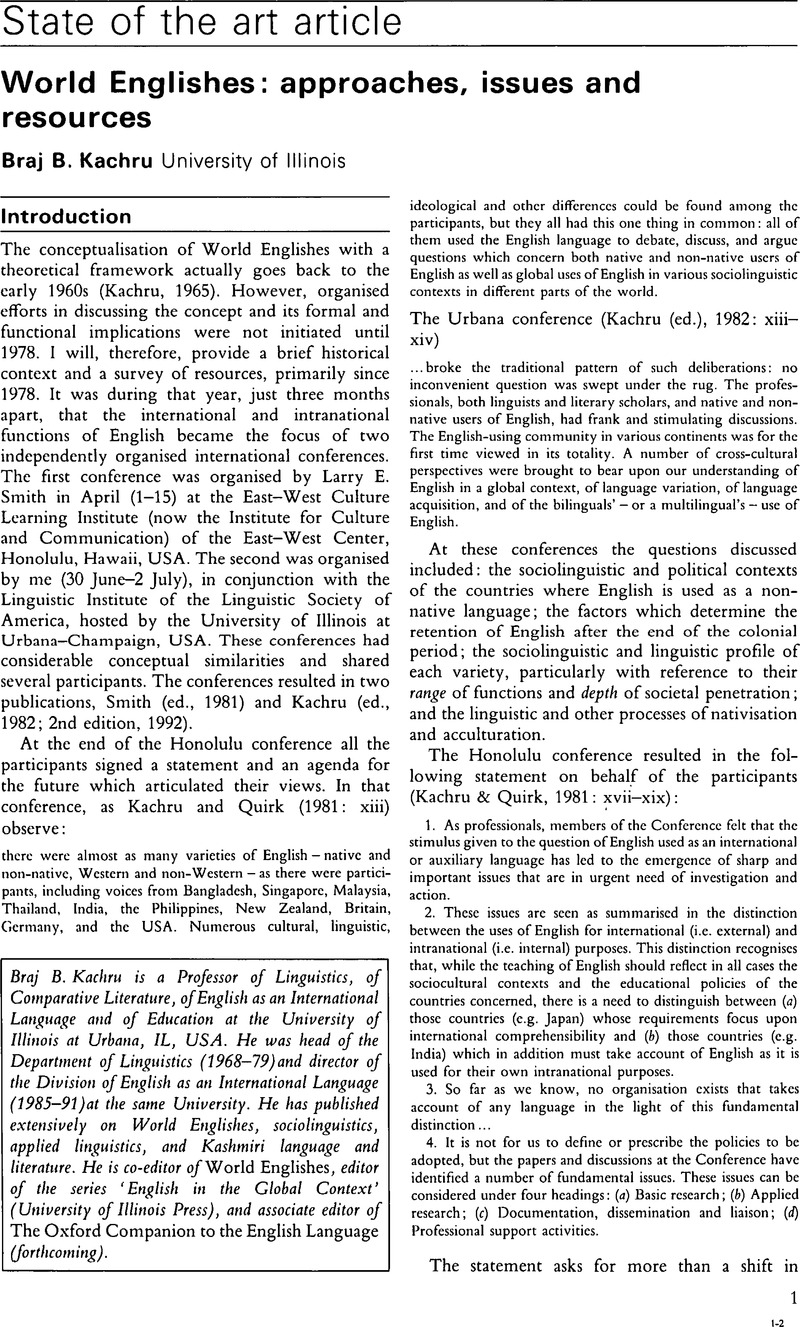Crossref Citations
This article has been cited by the following publications. This list is generated based on data provided by Crossref.
Pandey, Anita
and
Pandey, Anjali
1993.
NIGERIAN ENGLISH TODAY.
World Englishes,
Vol. 12,
Issue. 3,
p.
401.
Kachru, Braj B.
1993.
THE EMPIRE TALKS BACK.
World Englishes,
Vol. 12,
Issue. 3,
p.
393.
Kachru, Braj B.
1993.
Review of Görlach (1992): Englishes: Studies in varieties of English 1984–1988.
Journal of Pidgin and Creole Languages,
Vol. 8,
Issue. 2,
p.
269.
BAMIRO, EDMUND O.
1994.
Lexico‐semantic variation in Nigerian English.
World Englishes,
Vol. 13,
Issue. 1,
p.
47.
Boyle, Ron
1994.
ESP and distance learning.
English for Specific Purposes,
Vol. 13,
Issue. 2,
p.
115.
IWASAKI, YASUFUMI
1994.
Englishization of Japanese and acculturation of English to Japanese culture.
World Englishes,
Vol. 13,
Issue. 2,
p.
261.
Reves, Thea
and
Medgyes, Peter
1994.
The non-native english speaking EFL/ESL teacher's self-image: An international survey.
System,
Vol. 22,
Issue. 3,
p.
353.
Yajun, Jiang
1995.
Chinglish and China English.
English Today,
Vol. 11,
Issue. 1,
p.
51.
BAMIRO, EDMUND O.
1995.
Syntactic variation in West African English.
World Englishes,
Vol. 14,
Issue. 2,
p.
189.
Afendras, Evangelos A.
Millar, Sharon
Aogáin, Eoghan Mac
Bamgbo⋅e, Ayø
Kachru, Yamuna
Saleemi, Anjum P.
Preisler, Bent
Trudgill, Peter
Coulmas, Florian
and
Dasgupta, Probal
1995.
On ‘new/non-native’ Englishes: A gamelan.
Journal of Pragmatics,
Vol. 24,
Issue. 3,
p.
295.
Hargan, Noeleen
1995.
Misguided expectations: EFL teachers’ attitudes towards italian university students’ written work.
Language and Education,
Vol. 9,
Issue. 4,
p.
223.
KAY, GILLIAN
1995.
English loanwords in Japanese.
World Englishes,
Vol. 14,
Issue. 1,
p.
67.
HASSALL, PETER JOHN
1996.
INTERNATIONAL CONFERENCE ON WORLD ENGLISHES, NAGOYA, JAPAN MAY 1995.
World Englishes,
Vol. 15,
Issue. 3,
p.
419.
Roberts, Amy
1999.
Taming the monsters: practical intimacies in a third grade costa rican classroom.
Educational Action Research,
Vol. 7,
Issue. 3,
p.
345.
Árva, V
and
Medgyes, P
2000.
Native and non-native teachers in the classroom.
System,
Vol. 28,
Issue. 3,
p.
355.
Zhang, Lawrence Jun
2000.
A canon of wider choice.
English Today,
Vol. 16,
Issue. 3,
p.
55.
Rentz, Kathryn
2001.
A Flare from the Margins: The Place of Professional Writing in English Departments.
Pedagogy,
Vol. 1,
Issue. 1,
p.
185.
Adair, Vivyan C.
and
Dahlberg, Sandra L.
2001.
Cutting Class in the Multicultural Literature Classroom.
Pedagogy,
Vol. 1,
Issue. 1,
p.
173.
Blackburn-Brockman, Elizabeth
2001.
Editor's Introduction.
Pedagogy,
Vol. 1,
Issue. 1,
p.
167.
Lim, Shirley Geok-lin
2001.
English-Language Creative Writing in Hong Kong: Colonial Stereotype and Process.
Pedagogy,
Vol. 1,
Issue. 1,
p.
178.


